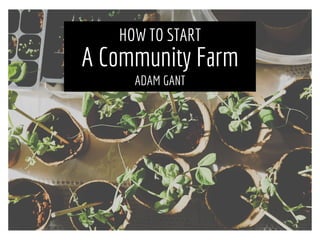How to Start a Community Farm | Adam Gant
- 1. HOW TO START A Community Farm ADAM GANT
- 2. The benefits of a community farm are plentiful, especially in urban areas, and they are a great way for you to get involved with your neighbors and form lasting connections.
- 3. What Is A Community Farm? Simply defined, a community farm is a shared plot of land that hosts produce, flowers, and other vegetation for anyone to use. These gardens are tended to by the community, meaning that anyone can plant seeds, water sprouts, and harvest fruits and vegetables. Often, community farms are started in order to provide healthy resources and cost- effective opportunities.
- 4. Getting Started One of the most important steps to take prior to starting a community farm entails actually communicating with members of your community and gauging their interest. Just connecting with your neighbors is a great start; showing them that you have an idea that would benefit everyone could be enough to convince them to support your initiative.
- 5. Identify Resources From available, fertile land to gardening equipment, ensuring you have what is necessary for the urban farm is essential. Connecting with individuals in your community who have?gardening or landscaping experience?will also be beneficial.
- 6. Establish Guidelines Budgeting finances and determining management duties is often a necessary aspect of beginning a community farm. Designating how you will receive funding for your farm¡ª through fundraising or membership dues, for instance¡ªand who will be responsible for tending to the garden throughout each week can help eliminate some stress and uncertainty. Putting these rules in writing is an important step to ensuring everyone involved has a sense of responsibility for the project.
- 7. Once you have taken the necessary steps for preparation, you can begin. The benefits of a community farm are immense, and starting one can improve your community by adding to available resources, providing green space, and encouraging community connection and engagement.
- 8. For more information, please visit: AdamGant.org








